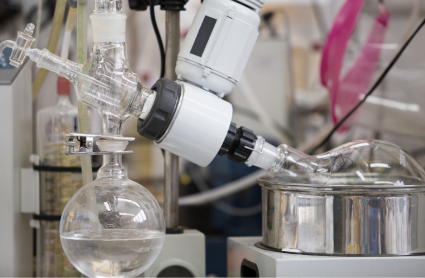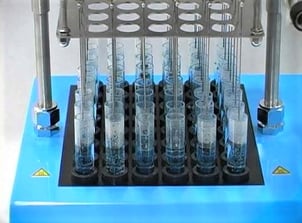
When visiting a laboratory to learn more about their research and required sample preparation, I typically ask, “if you were not using nitrogen to blow down your samples, how would you remove excess solvent from your vials?” The most common response is that a rotary evaporator would be used to dry down the samples instead.
In one way, this makes all the sense in the world as rotary evaporators are the most common type of sample concentrator. Not only is this the technique a chemist is most likely to be familiar with, it is also the evaporation tool most likely to already be in the laboratory. Rotary concentrators combine centrifugal force, applied through the sample vial’s rotation, with heat and vacuum. The vacuum allows the rotary evaporator to increase evaporation at a lower temperature while the rotation of the evaporation flask continuously spreads the sample across a larger surface area, which also speeds up the process.
If the lab is concentrating a few samples a week, employing a rotary unit could be a fine solution. An obvious drawback to rotary evaporation is that the chemist can only process one sample at a time. Sample prep can quickly become a bottleneck for a laboratory looking to analyze a batch of samples, never mind several batches per day.
 For example, the laboratory of a public utility company typically has 24 samples in a batch and they look to process two of these batches each day. Preparing 48 sample one after another is just not feasible!
For example, the laboratory of a public utility company typically has 24 samples in a batch and they look to process two of these batches each day. Preparing 48 sample one after another is just not feasible!
Another customer, an academic research laboratory, is extremely busy during the summer due to their focus on agriculture. During the summer, they process approximately 250 samples per day and told me that they rely on Organomation evaporators as “dry down steps are critical to the two assays that cover 99% of our workflows.”
.png?width=241&height=297&name=11802%20(4).png) Additionally, there are some samples which are just more difficult to process with rotary units. One example is generally smaller samples, for example, samples held within test tubes, microcentrifuge tubes or 96 well plates. Other approaches, such as nitrogen blowdown, are ideal for small starting volumes and concentrating them to 2 mL, 1 mL, or even to dryness.
Additionally, there are some samples which are just more difficult to process with rotary units. One example is generally smaller samples, for example, samples held within test tubes, microcentrifuge tubes or 96 well plates. Other approaches, such as nitrogen blowdown, are ideal for small starting volumes and concentrating them to 2 mL, 1 mL, or even to dryness.
An analytical laboratory we visited typically has a starting sample volume of 5 or 15 mL. While rotary evaporators vary in size, generally speaking, the smallest sample which can efficiently be processed in a unit is 25 mL. Nitrogen blow down provides the ability to dry multiple small samples at a time and is the preferred approach for chemists looking to optimize their sample preparation ahead of LC-GC and other analytical chemistry applications.
While rotary evaporation fits the needs of many general applications, it is certainly not the end-all, be-all solution. Where rotary evaporators fall short, nitrogen blowdown can offer a solution.
Still unsure which evaporation method is best for you? Take this evaporation method recommendation quiz to find out!
